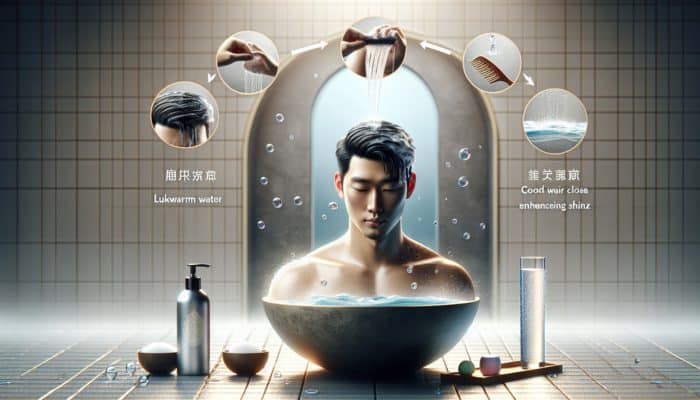Effective Strategies for Selecting the Perfect Shampoo Tailored to Your Hair Type
Choosing the right shampoo is essential for achieving and maintaining healthy hair while mastering effective hair washing techniques. Each unique hair type has specific needs that require formulations designed to cleanse effectively without stripping essential natural oils. The perfect shampoo should not only address your individual hair concerns but also promote optimal scalp health. By identifying your hair type, carefully analyzing ingredient lists, and establishing an appropriate washing routine, you can develop a comprehensive hair care regimen that enhances vitality, shine, and overall hair health over time.
Identifying Your Hair Type: A Key Step to Optimal Shampoo Selection

Recognizing your specific hair type is the foundational step in selecting the most effective shampoo for your needs. For instance, individuals with oily hair often benefit from a clarifying shampoo that effectively removes excess sebum, while those with dry hair should seek a moisturizing formula to provide essential hydration and restore shine. People with normal hair enjoy versatility, adapting to a variety of shampoos, but incorporating specific ingredients can further elevate its natural texture. For example, those with curly or textured hair should opt for shampoos infused with nourishing oils and humectants, which help maintain moisture levels and combat frizz for a well-defined look.
It's also vital to consider how environmental factors influence your hair's condition. For example, high humidity levels can exacerbate greasiness in oily hair, while colder weather can intensify dryness in others. Therefore, adjusting your shampoo choices according to seasonal changes and personal lifestyle choices is crucial for achieving the best possible hair outcomes and ensuring your hair remains looking its best throughout the year.
Understanding Shampoo Ingredients to Boost Hair Health
The ingredients present in your shampoo play a significant role in determining your hair's overall health and appearance. While components like sulfates are well-known for their cleansing abilities, they can also strip away natural oils, leading to dryness and scalp irritation. On the other hand, parabens serve as preservatives, but many individuals prefer to avoid them due to potential health concerns. Instead, opt for natural alternatives featuring plant-based ingredients that nourish your hair while minimizing harm.
Additionally, consider shampoos that contain beneficial elements such as proteins or vitamins that enhance hair structure and strength. For instance, shampoos rich in keratin can facilitate damage repair, while those containing panthenol provide moisture retention and improved shine. By consistently reading labels and comprehending the benefits of various ingredients, you empower yourself to make educated choices that align with your unique hair care objectives.
Finding the Ideal Hair Washing Frequency Based on Your Hair Type
The frequency with which you wash your hair should be tailored to your specific hair type, lifestyle, and scalp condition. For example, those with oily hair may feel the need to wash daily, while individuals with dry or curly hair might discover that washing just once or twice a week suffices. Over-washing, especially with harsh shampoos, can disrupt the natural oil balance of the scalp, leading to dryness and irritation that can exacerbate existing issues.
Lifestyle choices significantly influence how often you should wash your hair; individuals who regularly exercise may need to wash more frequently due to sweat and product buildup, whereas those in less physically demanding environments might benefit from washing less often. Ultimately, being attuned to the particular needs of your hair and scalp is essential for establishing a washing routine that yields the best results tailored to you.
Enhancing Hair Growth and Vitality by Prioritizing Scalp Health

Placing an emphasis on scalp health is crucial for implementing the best practices for washing hair properly. A well-maintained scalp acts as the foundation for strong and vibrant hair growth. Shampoos formulated to address specific scalp conditions, such as dandruff or irritation, can lead to noticeable improvements. Ingredients such as tea tree oil, zinc pyrithione, and salicylic acid are effective in combating dandruff, while soothing agents like aloe vera can calm an irritated scalp and restore balance.
Incorporating a scalp scrub or exfoliating treatment into your monthly routine can significantly aid in removing dead skin cells and product buildup, which not only enhances product absorption but also encourages healthier hair growth. Regular assessments of your scalp's condition and adjusting your hair care products accordingly can greatly improve your overall hair wellness and vitality, ensuring that your hair remains healthy and vibrant.
Essential Preparatory Steps for Your Hair Before Washing
Proper preparation is an essential yet frequently overlooked step in achieving the best practices for washing hair properly. Taking the time to adequately prepare your hair before washing can drastically enhance the effectiveness of your shampoo and overall hair health. From detangling to selecting the appropriate water temperature, each step is vital in nurturing your locks and maximizing their potential.
Effective Detangling Techniques to Implement Before Washing Hair
Detangling your hair prior to washing is a critical step that many individuals often neglect. By gently brushing out any knots, you can prevent breakage during the washing process. It is advisable to use a wide-tooth comb or a brush specifically designed to minimize damage, starting from the ends of your hair and working your way up towards the roots. This gentle technique reduces friction and aids in maintaining the integrity of your hair throughout the washing procedure.
Moreover, brushing before washing helps to distribute your scalp’s natural oils down to the ends of your hair, providing additional nourishment and promoting overall health. It’s best to perform this task on dry hair, as wet hair is more susceptible to breakage. Investing a few moments in detangling can save you from unnecessary damage and contribute to your hair looking its absolute best.
Selecting the Ideal Water Temperature for Hair Washing

The temperature of the water you use while washing your hair is pivotal to its health and appearance. Lukewarm water is ideal, as it opens the hair cuticles and allows the shampoo to cleanse effectively without stripping away vital natural oils. Hot water can lead to dryness and frizz, particularly for individuals with textured or colour-treated hair, while cold water may not cleanse effectively enough.
For the final rinse, consider switching to cool water; this helps seal the hair cuticles, enhancing shine and significantly reducing frizz. Being mindful of the water temperature is a simple yet effective practice that can elevate your hair washing routine and contribute to healthier, shinier hair that looks vibrant and full of life.
Boosting Your Hair Washing Routine with Soothing Scalp Massages
Incorporating a gentle scalp massage into your washing routine can significantly enhance blood circulation and promote healthier hair growth. As you apply shampoo, use your fingertips to massage it into your scalp in circular motions. This technique not only helps distribute the shampoo evenly but also creates a soothing experience that alleviates tension and promotes relaxation.
Regular scalp massages can also improve scalp health by stimulating oil production, which nourishes hair follicles and contributes to overall hair vitality. Making this practice a ritualistic part of your hair washing routine can yield noticeable improvements in both hair health and overall well-being, resulting in more resilient and beautiful hair.
Proven Techniques for Applying Shampoo Effectively
The method you use for applying shampoo can have a substantial impact on your hair's cleanliness and overall health. Mastering the art of effective shampoo application guarantees that your hair is thoroughly cleansed while minimizing damage, allowing it to thrive. Consider the amount of shampoo, lathering techniques, and the significance of thorough rinsing to achieve optimal results and maintain your hair's natural beauty.
Determining the Right Amount of Shampoo for Your Hair Type
Using the appropriate amount of shampoo is vital; too much can lead to buildup and dryness, while too little may not cleanse effectively. A general guideline is to use a quarter-sized amount for short to medium-length hair and increase the quantity as needed for longer locks.
It’s essential to concentrate on the scalp during shampoo application, as this area tends to accumulate the most oil and product buildup. Ensuring even distribution of the shampoo is key; gently work it through your hair and scalp to avoid tangling or breakage. Adjust your quantity based on your hair's length, texture, and oiliness to achieve the best cleansing results tailored to your unique hair needs.
Mastering the Lathering Process for Optimal Cleansing
Creating a rich, foamy lather is essential for effective cleansing. Start by applying the shampoo to your scalp and gently massaging it in with your fingertips. This method ensures that the shampoo targets oil and dirt effectively at the roots, providing a deep clean that invigorates your scalp.
Once you’ve created a lather, gradually work your way down to the tips of your hair, which typically require less shampoo. It’s crucial to avoid scrubbing too harshly, as this can result in breakage and damage. Instead, use a gentle touch to work the product through your hair, ensuring that all strands are coated and thoroughly cleansed for a fresh and healthy look.
The Importance of Thorough Rinsing for Healthy Hair Maintenance
Thorough rinsing is an often-overlooked aspect of washing hair that can greatly impact its health and appearance. Leaving shampoo residue in your hair can lead to buildup, irritation, and an unclean feeling that detracts from your hair's natural beauty. Ensure that you rinse your hair thoroughly until the water runs clear, checking from multiple angles to confirm that all product has been completely removed for optimal hair health.
Consider using a showerhead with adjustable settings to control the water flow, allowing for a more targeted rinse. A comprehensive rinse lays the groundwork for the subsequent steps in your hair care routine, ensuring that your hair remains clean, healthy, and vibrant.
Maximizing Hair Nourishment Through Effective Conditioning Practices
Conditioning is a vital aspect of the best practices for washing hair properly. It not only nourishes and hydrates but also acts as a protective barrier against damage caused by environmental stressors and styling practices. Selecting the right conditioner and mastering the application technique can lead to substantial improvements in your hair’s health, manageability, and overall appearance.
Choosing the Most Suitable Conditioner for Your Specific Hair Type
Selecting a conditioner that complements your shampoo is crucial for achieving optimal results. Look for formulations tailored to your specific hair type; for instance, if you have dry hair, a rich, moisturizing conditioner with ingredients like argan oil or shea butter can provide essential nourishment. Conversely, individuals with fine hair might prefer a lightweight conditioner that won’t weigh their hair down.
Pay attention to your hair's individual needs; if you’re experiencing damage from heat styling or chemical treatments, consider using a protein-rich conditioner to restore strength and elasticity. Understanding your hair's condition and specific requirements will guide your selection, ensuring that you provide it with the best possible care tailored to its unique characteristics for optimal health and vibrancy.
Strategic Application Techniques to Maximize Conditioning Benefits
Applying conditioner correctly is just as important as selecting the right product. Concentrate on the ends of your hair, where damage is often most pronounced and where moisture is greatly needed. Avoid applying conditioner directly to the scalp, as this can lead to greasiness and weigh down your roots, ultimately resulting in a flat appearance.
Use your fingers or a wide-tooth comb to distribute the conditioner evenly through the lengths and ends of your hair. For a more intense conditioning treatment, consider using a shower cap to trap heat, allowing the conditioner to penetrate more deeply into the hair shaft. This technique can significantly enhance hydration and improve your hair’s overall health, softness, and manageability.
Maximizing Leave-In Time for Enhanced Conditioning Effects
Allowing your conditioner to sit for a few minutes before rinsing can greatly boost its effectiveness. During this time, the product can penetrate the hair shaft, delivering deep hydration and nourishment that your hair craves to look its best.
If you're short on time, even allowing the conditioner to remain in for just a minute can still be beneficial, but aim to make it a habit to leave it in for three to five minutes whenever possible. This simple practice can lead to smoother, shinier hair that’s easier to manage, ensuring you fully reap the benefits of your conditioning treatment and enjoy the results of your hair care efforts.
Best Practices for Safely Drying Your Hair to Preserve Health
The method you choose to dry your hair can significantly impact its overall health and appearance. Understanding the various drying techniques and their implications will enable you to maintain the integrity of your hair while achieving your desired style. From towel drying to implementing heat protection measures, each step plays a critical role in your hair care routine and overall hair health.
Gentle Towel Drying Techniques to Minimize Damage and Frizz
Towel drying is a common practice, but it’s crucial to do it gently to prevent damage. Instead of vigorously rubbing your hair, which can lead to frizz and breakage, gently pat your hair with a soft, absorbent towel.
Microfiber towels are an excellent alternative to traditional cotton towels, as they are gentler on the hair and help reduce friction. By treating your hair delicately during this stage, you can preserve its health and enhance its overall appearance, leading to a more polished and refined look that reflects your hair's natural beauty.
Weighing the Benefits of Air Drying Compared to Blow Drying
The choice between air drying and blow drying often comes down to personal preference but can have significant implications for your hair's health. Air drying is the gentler option, allowing hair to dry naturally without the risk of heat damage, making it particularly beneficial for textured or colour-treated hair.
If blow drying is necessary, opt for a low heat setting and maintain a distance of at least six inches from your hair to minimize damage. Using a diffuser attachment can be especially beneficial for those with curly or wavy hair, as it prevents frizz while maintaining curl definition. Always remember to apply heat protectant products, as they provide an essential barrier against damage during the drying process, helping to keep your hair looking healthy and vibrant.
Gentle Combing Techniques for Effective Wet Hair Maintenance
Combing wet hair requires a cautious approach, as hair is more fragile when damp. Use a wide-tooth comb to gently detangle your locks, starting from the ends and working your way up to the roots. This method minimizes breakage and helps maintain hair integrity throughout the process.
Avoid using traditional brushes on wet hair, as they can cause damage and result in increased split ends. Instead, reserve a wide-tooth comb specifically for your wet hair routine, ensuring that your hair remains healthy and tangle-free, ultimately contributing to its overall appearance and vitality.
Importance of Applying Heat Protectant Products for Hair Safety
Before using any heated styling tools, applying a heat protectant is essential. These products create a protective barrier that shields your hair from the damaging effects of heat styling. Look for sprays or creams containing beneficial ingredients such as silicones or natural oils, which help protect against moisture loss while providing effective heat defense.
When styling, ensure that you distribute the heat protectant evenly throughout your hair, paying particular attention to the ends where damage is most likely to occur. Incorporating this step into your styling routine will help mitigate heat damage and preserve the overall health of your hair, ensuring that it remains vibrant and strong.
Final Touches and Personalized Styling Techniques for a Flawless Look
Once your hair is dry, it’s time to apply the finishing touches. Using a brush or your fingers, style your hair according to your preference. A light application of hairspray can help maintain your style without creating a stiff or crunchy appearance that detracts from your hair’s natural beauty.
Consider incorporating styling products specifically formulated for your hair type and desired look. For instance, volumizing mousse can add body to fine hair, while curl cream enhances natural waves for a more polished finish. Customizing your styling routine to align with your hair's unique characteristics will ensure that you achieve your best possible look while nurturing its health and vitality.
Customized Approaches for Diverse Hair Types to Maximize Care
Different hair types require personalized approaches for optimal care. Understanding the distinct needs of your hair type—whether it’s curly, straight, fine, wavy, or coily—is essential for maintaining its health and beauty. Implementing targeted strategies ensures adherence to the best practices for washing hair properly, tailored specifically to your hair type for the best results.
Specialized Care Techniques for Nurturing Healthy Curly Hair
Caring for curly hair necessitates a unique approach that prioritizes moisture retention and curl definition. Curly hair often tends to be drier due to its structure, making the use of a hydrating shampoo and a rich conditioner essential for maintaining healthy curls. Seek out products specifically formulated for curls, as they usually contain ingredients that enhance curl definition while minimizing frizz and promoting shine.
Avoid excessive washing; consider co-washing with a cleansing conditioner to help maintain moisture levels. Additionally, using a leave-in conditioner after washing can aid in defining curls and providing ongoing hydration throughout the day. Incorporating a lightweight styling gel can further enhance curl definition without weighing your hair down, resulting in beautifully defined and bouncy curls that look vibrant and full of life.
Techniques to Maintain Shine and Softness in Straight Hair
For straight hair, the focus should be on maintaining shine and softness. Consistent conditioning is crucial; consider using a lightweight conditioner that won’t weigh your hair down. Integrating a clarifying shampoo into your routine once a month can help remove buildup and enhance shine for a polished and sleek look.
Limiting heat styling is vital for preserving the health of straight hair. When heat styling is necessary, always use a heat protectant and opt for lower heat settings to minimize damage. Regular trims will also help prevent split ends and keep your hair looking fresh, vibrant, and healthy, maintaining its natural beauty and shine for longer.
Strategies for Caring for Fine Hair Effectively
Fine hair requires special attention to prevent breakage and add volume. Opt for volumizing shampoos and conditioners that are lightweight to avoid weighing your hair down and causing limpness. Steer clear of heavy oils or creams, as these can leave fine hair looking flat and lifeless.
Gentle handling is crucial; when drying or styling, select products that contribute texture and body without causing damage. Consider using dry shampoo between washes to boost volume and freshness, giving your hair a lift. Regular trims can also help maintain the health of fine hair by preventing split ends and promoting a thicker appearance that looks full of life.
Effective Techniques for Caring for Wavy Hair to Enhance Definition
Wavy hair often features a blend of textures, necessitating a balanced care regimen. Lightweight products are ideal for enhancing waves without adding unnecessary heaviness. Use a curl-enhancing shampoo and a lightweight conditioner to maintain moisture without sacrificing volume and bounce.
Diffusing while drying can help define waves and reduce frizz, resulting in a polished look that showcases your natural texture. Consider using a sea salt spray to enhance texture and achieve that effortless beachy finish. When styling, embrace your natural wave pattern and avoid excessive heat styling to maintain the integrity of your hair and its natural beauty.
Moisture-Rich Essentials for Caring for Coily Hair to Prevent Dryness
Coily hair thrives on moisture, making it essential to invest in rich oils and butters that provide deep nourishment. Seek out shampoos and conditioners specifically designed for coily hair that deliver hydration and nourishment to prevent dryness and breakage. Regular deep conditioning treatments are crucial for maintaining well-defined and healthy coils.
Incorporating protective styling, such as braids or twists, can help retain moisture and reduce breakage. Utilize a leave-in conditioner and seal with an oil to effectively lock in hydration and keep your coils looking vibrant and full of life. By prioritizing moisture and protection, you can maintain the beauty and health of your coily hair, allowing it to flourish and shine.
Effective Solutions for Common Hair Care Challenges
Addressing common hair concerns is a vital component of achieving the best practices for washing hair properly. From dandruff to oily scalp conditions, understanding how to manage these challenges will enhance your hair care routine and promote overall hair health.
Strategies for Effectively Controlling Dandruff
Dandruff can be an annoying issue that affects many individuals. To effectively manage flakes and irritation, consider using anti-dandruff shampoos enriched with active ingredients like ketoconazole or zinc pyrithione. These components target the underlying causes of dandruff, helping to maintain a healthy scalp and reducing flakiness over time.
Maintaining a consistent washing schedule is vital; aim to cleanse your scalp two to three times a week. Additionally, incorporating a scalp massage during washing can improve blood circulation and promote a healthier scalp environment. Keeping stress levels in check and maintaining a balanced diet can also positively contribute to better scalp health, helping you combat dandruff effectively.
Strategies for Effectively Managing an Oily Scalp
An oily scalp can create an unappealing greasy appearance and may require a different approach to care. Opt for shampoos formulated for oily hair, which typically contain clarifying ingredients designed to eliminate excess sebum effectively. It’s essential to resist the temptation to wash your hair daily, as over-washing can trigger increased oil production, leading to a cycle of oiliness that is hard to break.
Consider using dry shampoo in between washes to absorb excess oil and refresh your hair without excessive washing. Additionally, avoid heavy styling products that may contribute to buildup on the scalp. A consistent hair care routine tailored to your scalp's specific needs will help achieve a balanced and healthy appearance, ensuring your hair looks its best every day.
Gentle Care Practices to Prevent Hair Loss
Preventing hair loss begins with adopting gentle hair care practices. Avoid harsh treatments or excessive styling that can lead to damage and breakage. Consider using shampoos containing ingredients known to promote hair growth, such as biotin or saw palmetto, which can help stimulate healthy hair growth and maintain your hair's fullness and thickness.
Regular scalp massages can stimulate blood flow to the hair follicles, encouraging healthier hair growth. If you notice significant hair loss, consulting a healthcare professional may provide insights into potential underlying issues and suitable treatments, such as topical solutions or dietary changes that can support hair health and reduce hair loss over time.
Frequently Asked Questions About Hair Care Best Practices
What is the recommended frequency for washing my hair to maintain health?
The frequency of washing your hair is influenced by your hair type and lifestyle. Oily hair may necessitate daily washing, whereas dry or curly hair could benefit from washing just once or twice a week to maintain balance and prevent unnecessary dryness.
Can I use the same shampoo for different hair types within my household?
While it’s feasible to use the same shampoo, it’s advisable to select a shampoo that caters specifically to each individual's hair type for optimal results and health benefits, ensuring everyone achieves their best hair.
Which ingredients should I avoid in shampoos to protect my hair?
Avoid harsh sulfates and parabens, as these can strip your hair of essential oils and cause irritation. Instead, seek out natural and nourishing ingredients that promote hair health and enhance your hair's overall appearance.
Is it preferable to air dry or blow dry my hair for optimal health?
Air drying is generally the gentler option and helps maintain hair health. If blow drying is necessary, utilize a low heat setting and always apply a heat protectant to minimize potential damage to your hair.
How can I enhance my scalp health and overall hair vitality?
To improve scalp health, maintain a regular washing routine, use scalp-specific treatments for issues like dandruff, and incorporate gentle massages during washing to enhance circulation and promote a healthier scalp environment.
Should I condition my hair every time I wash it for the best results?
Yes, conditioning each time you wash your hair is beneficial, as it helps replenish moisture and prevents damage, ensuring your hair remains healthy, vibrant, and easy to manage.
What is the best method for detangling wet hair without causing damage?
Utilize a wide-tooth comb to gently detangle wet hair, starting from the ends and working your way up to avoid breakage and maintain hair integrity throughout the process.
How can I effectively manage frizz in my hair for a smoother appearance?
To control frizz, use anti-frizz serums or oils, and limit excessive heat styling. Regular conditioning also aids in locking in moisture, resulting in smoother hair that looks polished and well-groomed.
Are there specific products available for maintaining the health of colour-treated hair?
Yes, look for shampoos and conditioners specifically formulated for colour-treated hair, as they help maintain vibrancy and moisture levels, ensuring the longevity of your color while keeping your hair healthy.
Can my diet influence the health of my hair and its growth?
Absolutely, a balanced diet rich in vitamins and minerals is essential for supporting hair health. Nutrients such as biotin, zinc, and omega-3 fatty acids are particularly beneficial for promoting strong and healthy hair.
Connect with us on Facebook for more tips and updates!
The Article: Best Practices for Washing Hair Properly: A Comprehensive Guide appeared first on Amitys Hair Salon.
The Article Washing Hair Properly: Essential Best Practices Guide Was Found On https://limitsofstrategy.com

